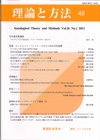Volume 27, Issue 1
Displaying 1-13 of 13 articles from this issue
- |<
- <
- 1
- >
- >|
Presidential Address
-
2012Volume 27Issue 1 Pages 1-18
Published: 2012
Released on J-STAGE: March 18, 2013
Download PDF (485K)
Special Issue: Development of Panel Data Analysis in Sociology
-
2012Volume 27Issue 1 Pages 19-22
Published: 2012
Released on J-STAGE: March 18, 2013
Download PDF (382K) -
2012Volume 27Issue 1 Pages 23-40
Published: 2012
Released on J-STAGE: March 18, 2013
Download PDF (566K) -
2012Volume 27Issue 1 Pages 41-62
Published: 2012
Released on J-STAGE: March 18, 2013
Download PDF (1117K) -
2012Volume 27Issue 1 Pages 63-84
Published: 2012
Released on J-STAGE: March 18, 2013
Download PDF (654K) -
2012Volume 27Issue 1 Pages 85-98
Published: 2012
Released on J-STAGE: March 18, 2013
Download PDF (632K)
Articles
-
2012Volume 27Issue 1 Pages 99-116
Published: 2012
Released on J-STAGE: March 18, 2013
Download PDF (578K) -
2012Volume 27Issue 1 Pages 117-130
Published: 2012
Released on J-STAGE: March 18, 2013
Download PDF (731K) -
2012Volume 27Issue 1 Pages 131-148
Published: 2012
Released on J-STAGE: March 18, 2013
Download PDF (482K) -
2012Volume 27Issue 1 Pages 149-168
Published: 2012
Released on J-STAGE: March 18, 2013
Download PDF (544K)
Communications
-
2012Volume 27Issue 1 Pages 169-174
Published: 2012
Released on J-STAGE: March 18, 2013
Download PDF (393K)
Seminar: Methods of Mathematical Sociology (4)
-
2012Volume 27Issue 1 Pages 175-186
Published: 2012
Released on J-STAGE: March 18, 2013
Download PDF (1047K)
Book Reviews
-
2012Volume 27Issue 1 Pages 187-199
Published: 2012
Released on J-STAGE: March 18, 2013
Download PDF (771K)
- |<
- <
- 1
- >
- >|
